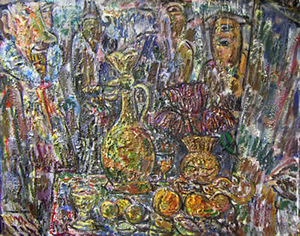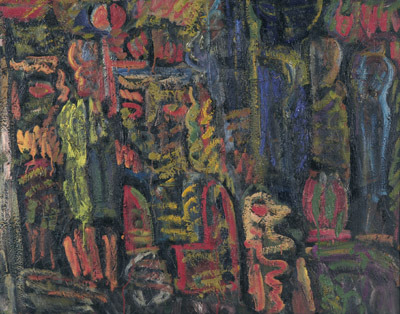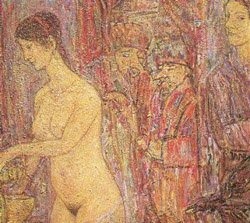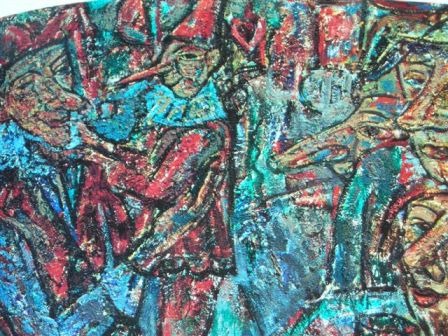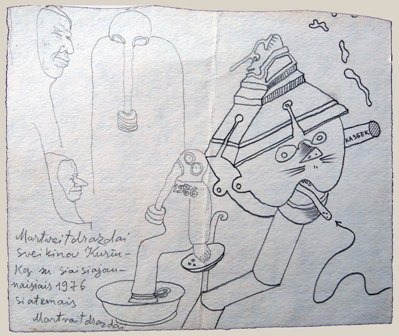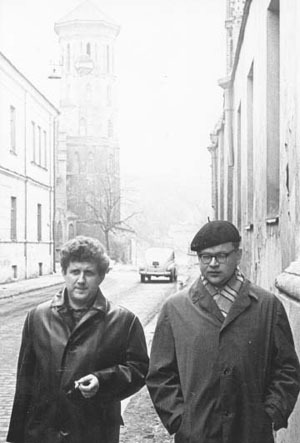IN MEMORIAM OF A.MARTINAITIS. OUR UNTĖ 0
(Memories of a friend and comrade-in-arms) Edmundas Saladžius www.kamane.lt , 2008 10 09
A.Martinaitis. "Still-life". 1987
A.Martinaitis. "Still-life with Birds". 1980-1985
A.Martinaitis. "We All Love Pinoccio". 1980 (fragment)
A.Martinaitis. "Drawing". 1976
A.Martnaitis and poet A.Mikuta. 1970. Photo by R.Rakauskas In brief: The author knew the painter Antanas Martinaitis since the mid of the seventh decade of the 20th century. Antanas Martinaitis and his friend Ričardas Vaitiekūnas invaded Kaunas and rocked the grey provincial life of Kaunas painters. Paintings of Antanas flickering with colours caused concern and excitement among visitors of vernissages of those times.There existed a rather good and safe hideaway for artists, who had a different vision of the world and their country than the ones who resided in the stern building at the beginning of Laisvės Alley, near Sobor, in the shabby Kaunas secondary art school headed by Director Laima Baranauskienė.Antanas used to become the organiser and artist of events at the school. Attacks of glee were sometimes replaced by deep thoughts in the life of the painter. Then again, after pushing the dark mood further, Antanas used to say a snappy quatrain. During the free time after corrections of pupils’ works, the artists sat and drew “psychedelic” drawings, which revealed their fantasies and expectations subconsciously.One could feel that Antanas inherited talent from his energetic father – Jonas Martinaitis, who created watercolours and illustrated the magazine Naujas Žodis (New Word) during the inter-war period.The workshop of A.Martinaitis was located in a large grey house near Pergalė quay then (Karaliaus Mindaugo Ave. at the moment). A gaunt yard could be seen via the dirty window. The building was constructed by captives of Germans in the post-war period.Later the painter A.Martinaitis was granted a workshop in the old town of Kaunas, in M.Daukša Street. The fact that Untė (he was called so at that time) would be able to paint further was very rejoicing. There was a balcony in the mezzanine, where one could smoke and enjoy the view of the tin roof of Kaunas Cathedral Basilica.Differently from workshops of other Kaunas painters, the space of creation of Antanas did not turn into a cosy boudoir or saloon. It was a place of work and thinking. The floor became covered with spots of paint soon, the same fate awaited for the chairs of Smetona times and the desk.The most important object was the easel covered in paint and the famous palette that weighed several kilos due to the “cultural layer” on it. The floor was frayed till bare wood near the easel, it was the place where Untė stood while painting. Antanas worked intensively all his life – he improved and repainted his works constantly. The multi-layered paintings reminded of work of a villager – ploughman in a way. Like Saint Isidore he ploughed the soil of his paintings and raised them to the heights of the spirit. He worked zestfully proving once again in the way known to him only that art was a miracle rather than a toy for a snot. It seems to me that the happiest days of Antanas’ life were spent in Kačerginė, when they moved to this suburb of Kaunas that smelled of pines. Doomed to live in small rooms, he did not complain. He did not ask for a bigger apartment, did not try to please authorities of those times. Shortcomings of daily life were compensated by the wonderful nature, the Nemunas river, the corners of the woods known to him and his wife Adelija only, mysterious sources and mushrooms growing near them silently. Antanas was happy in Kačerginė.It is a pity that no monograph about the painter A.Martinaitis has been written yet - the painter has glued a very strong bit of his creative work to the big art nest of a small nation. Our Untė is worth the remembrance.***Antanas and cold bortschWe are sitting with Antanas in the dining-room of the former Tartu café at a plate of cold bortsch. Mid-summer. Emanuelis Z. and Rolandas P. not known to the world yet are eating their soups at another two tables. Suddenly sirens start howling and loudspeakers order to get out of the way – a cortege of Soviet employees is going. Antanas tells to everybody to stand up and orders: “Still! Honour authorities by spoons!”Antanas and a henAntanas decided to buy a hen in Kaunas and to bring it back home to Kačerginė. We dropped to my home accidentally on the way, and my mother treated us with tasty meatballs. As a result, Antanas stayed for the night. We noticed in the morning that the hen obtained slightly blue colour and started smelling of carrion. Antanas pronounced sadly: “Don’t praise a hen until the evening.” (A rephrased Lithuanian saying “Don’t praise the day until the evening”.)Antanas and cat MicėI woke up in my room one morning due to cheeping in many different voices. It appeared that the cat Micė gave birth to its kittens in the bed where Antanas was sleeping at night. Surrounded by blind kittens, Untė sat up carefully and said: “You see, Edmundas, cats give birth to kittens only on a good man.”Antanas and principlesDuring the reconstruction of Kaunas musical theatre we, Kaunas artists, were offered to create “some art” for decorating future premises. Sitting on the stage, we were waiting for a responsible Soviet employee to arrive. The employee showed ideological trust in the painter Antanas Martinaitis and offered him to paint a thematic canvas dedicated to the parliament meeting of July 21, which consolidated the Soviet authorities. The clouded glasses of Antanas betrayed his range and excitement. “I do not paint parliaments!” he stated briefly.The slightly intoxicated stained-glass artist Henrikas Kulšys, who also participated in the meeting, overturned along with his chair from surprise. Antanas used to be determined and bold in important moments.Antanas and the actorAntanas Martinaitis received an order for a large thematic painting “Actors of Kaunas Musical Theatre”. It was a very interesting composition; unfortunately, it remained unfinished. Surely, actors are as whimsical as painters and want to look impressively in paintings as well as on the stage and in life. There was a portrait of the inventive actor Vincas Čižauskas among others. Čižas tried hard to make an impact on his image and tired Antanas with that. The painter lost patience finally and ripped out: “Čyžas, if you do not buy me a drink immediately (cognac – author’s note), I will hide your image under paint at this very moment!”








